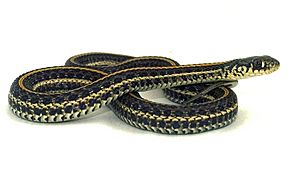Plains garter snake facts for kids
Quick facts for kids Plains garter snake |
|
|---|---|
 |
|
| Conservation status | |
| Scientific classification | |
| Genus: |
Thamnophis
|
| Species: |
radix
|
| Synonyms | |
The plains garter snake (Thamnophis radix) is a type of garter snake found in many parts of the central United States, stretching north into Canada and south into Texas. You can often spot this snake by its bright orange or yellow stripe running from its head all the way to its tail. The rest of its body is usually a gray-green color. These snakes often live near water, like streams and ponds. But sometimes, you might even find them in cities, in empty lots! Even though this snake is mildly venomous, its venom is not harmful to humans.
Contents
About the Plains Garter Snake
What Does It Look Like?
The plains garter snake has a clear orange or yellow stripe down its back. It also has special black bars on its lips. This main stripe usually goes from the snake's head all the way to the tip of its tail.
On the sides of its body, there are greenish-yellow stripes. These are found on the third and fourth rows of scales. Its belly is gray-green and has small dark spots along the edges. Most of these snakes also have light yellow spots on top of their heads. This snake is considered medium-sized. It usually grows to be about 3 ft (0.91 m) long.
Behavior and Life Cycle
The plains garter snake is known for being very good at handling cold weather. On warmer days in winter, it often comes out of its hibernation spot to warm up in the sun. These snakes are most active between April and late October, depending on where they live.
Mating usually happens in April or May. The baby snakes are born between August and October. Courtship often takes place near where the snakes hibernate together. The snake's main diet includes earthworms, slugs, and small amphibians, like young salamanders. They have also been seen eating small mammals and birds.
Where Do Plains Garter Snakes Live?
Habitat and Environment
The plains garter snake is commonly found in meadows and prairies. They like to be near water sources such as marshes, streams, and ponds. In cities like the Chicago area, they have been seen in old buildings, trash piles, and empty lots.
However, in city and suburban areas, their numbers have gone down. This is because of new buildings and the use of pesticides. The plains garter snake often lives in the same areas as the common garter snake. Scientists think these two types of snakes might even breed together sometimes.
Geographic Range
This snake lives across a large part of North America. You can find it as far north as central Alberta in Canada. It also lives as far south as Northern Texas and New Mexico in the United States.
In the U.S., it is found in many states. These include Iowa, eastern Wyoming, northern Kentucky, eastern Colorado, Minnesota, southern Wisconsin, Illinois, northwestern Indiana, Oklahoma, Nebraska, and northern Missouri. A small group of them also lives in Ohio. In Canada, they are also found in Manitoba. They can live at different heights, from 400 to 7,500 feet above sea level. But they prefer to stay below 6,000 feet.
Conservation Status
The plains garter snake is listed as Least Concern by the IUCN Red List. This means that globally, there is not much worry about them disappearing. This is because they can adapt to different places, are found over a wide area, and are thought to have a large population.
However, in some states, they are more at risk. For example, in Ohio, the species is considered endangered. In Wisconsin, it is listed as a species of special concern. This means people are keeping a close eye on them there.



